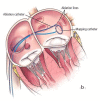Radiofrequency ablation for treatment of atrial fibrillation
- PMID: 23678423
- PMCID: PMC3648962
- DOI: 10.5681/bi.2011.023
Radiofrequency ablation for treatment of atrial fibrillation
Abstract
Introduction: Atrial Fibrillation (AF) is the most common cardiac arrhythmia which represents a major public health problem. The main purpose of this research is to evaluate the Radiofrequency (RF) ablation effects in the patients with chronic AF scheduled for cardiac surgery because of different heart diseases.
Methods: The descriptive and prospective study was conducted on 60 patients with AF scheduled for surgery along with RF ablation. The data were collected by questionnaire and included: patients' age, sex, NYHA class, operation type, past medical history, type and cause of valvular heart disease, preoperative ECG (electrocardiogram), duration of surgery, clamping time, cardiopulmonary bypass, and RF ablation time. RF ablation was followed by the main operation. The follow up examination, ECG, and echocardiography were performed 3 and 6 months after operation.
Results: The mean age of patients was 48±10 years (18-71 years). Forty one patients had permanent AF and 19 had the persistent AF. The left ventricular ejection fraction was 48.27±9.75 percent before operation, and reached to 56.27±7.87 percent after the surgery (P<0.001). The mean NYHA class before the surgery was 2.83±0.68 which decreased to 1.34±0.46 6 months after the surgery with RF ablation (P<0.001). One patient (1.6%) died after surgery. Complete relief and freedom from AF recurrence was observed in 70% of patients in the mean follow up in 7 months after the surgery. The sinus rhythm with efficient atrial contraction was established in 100% of discharged patients.
Conclusion: RF ablation is an effective procedure to cure atrial fibrillation in patients undergoing cardiac surgeries.
Keywords: Arrhythmia; Atrial fibrillation; Radiofrequency ablation; Sinus rhythm.
Similar articles
-
Factors related to sinus rhythm at discharge after radiofrequency ablation of permanent atrial fibrillation in patients undergoing mitral valve surgery.Heart Vessels. 2016 Apr;31(4):593-8. doi: 10.1007/s00380-015-0647-3. Epub 2015 Feb 14. Heart Vessels. 2016. PMID: 25680414
-
A case-matched comparative study of surgical radiofrequency (RF) ablation for patients with persistent or long-standing atrial fibrillation undergoing concomitant heart surgery.Hellenic J Cardiol. 2012 Nov-Dec;53(6):420-5. Hellenic J Cardiol. 2012. PMID: 23178424
-
Predictive factors of sustained sinus rhythm and recurrent atrial fibrillation after a radiofrequency modified Maze procedure.Eur J Cardiothorac Surg. 2008 Oct;34(4):771-5. doi: 10.1016/j.ejcts.2008.07.026. Epub 2008 Sep 2. Eur J Cardiothorac Surg. 2008. PMID: 18768326
-
The efficacy of intraoperative atrial radiofrequency ablation for atrial fibrillation during concomitant cardiac surgery-the Surgical Atrial Fibrillation Suppression (SAFS) Study.J Interv Card Electrophysiol. 2011 Oct;32(1):29-35. doi: 10.1007/s10840-011-9576-y. Epub 2011 Jun 18. J Interv Card Electrophysiol. 2011. PMID: 21687970 Review.
-
How effective is bipolar radiofrequency ablation for atrial fibrillation during concomitant cardiac surgery?Interact Cardiovasc Thorac Surg. 2012 Oct;15(4):741-8. doi: 10.1093/icvts/ivs311. Epub 2012 Jul 19. Interact Cardiovasc Thorac Surg. 2012. PMID: 22815321 Free PMC article. Review.
Cited by
-
Ablation Modalities for Therapeutic Intervention in Arrhythmia-Related Cardiovascular Disease: Focus on Electroporation.J Clin Med. 2021 Jun 16;10(12):2657. doi: 10.3390/jcm10122657. J Clin Med. 2021. PMID: 34208708 Free PMC article. Review.
-
Initial outcome following invasive cardiac electrophysiologic studies and radiofrequency ablation of atrial fibrillation.Int J Appl Basic Med Res. 2016 Apr-Jun;6(2):90-5. doi: 10.4103/2229-516X.179014. Int J Appl Basic Med Res. 2016. PMID: 27127736 Free PMC article.
-
Ganglionated Plexi Ablation for the Treatment of Atrial Fibrillation.J Clin Med. 2020 Sep 24;9(10):3081. doi: 10.3390/jcm9103081. J Clin Med. 2020. PMID: 32987820 Free PMC article. Review.
-
A Rare Case of Bronchopericardial Fistula Following Atrial Fibrillation Ablation.J Atr Fibrillation. 2019 Jun 30;12(1):2233. doi: 10.4022/jafib.2233. eCollection 2019 Jun. J Atr Fibrillation. 2019. PMID: 31687074 Free PMC article.
-
Right phrenic nerve palsy following transcatheter radiofrequency current atrial fibrillation ablation: Case report.J Int Med Res. 2019 Jul;47(7):3438-3443. doi: 10.1177/0300060519849267. Epub 2019 May 30. J Int Med Res. 2019. PMID: 31144560 Free PMC article.
References
-
- Aikawa M, Watanabe H, Shimokawa T, Inoue K, Takamisawa I, Seki A, et al.2009 Preoperative left atrial emptying fraction is a powerful predictor of successful maze procedure. Circ J, 73(2), 269-273 - PubMed
-
- Beukema R, Beukema W, Sie H, Ramdat Misier A, Delnoy PP and Elvan A. 2009. Monitoring of atrial fibrillation burden after surgical ablation: relevancy of end-point criteria after radiofrequency ablation treatment of patients with lone atrial fibrillation. Interact Cardiovasc Thorac Surg. - PubMed
-
- Bevilacqua S, Gasbarri T, Cerillo AG, Mariani M, Murzi M, Nannini T, et al.2009 A new vacuum-assisted probe for minimally invasive radiofrequency ablation. Ann Thorac Surg, 88(4), 1317-1321 - PubMed
-
- Bonanno C, Paccanaro M, La Vecchia L, Ometto R and Fontanelli A. 2009. Efficacy and safety of catheter ablation versus antiarrhythmic drugs for atrial fibrillation: a meta-analysis of randomized trials. J Cardiovasc Med. (Hagerstown). - PubMed
-
- Bonanno C, Paccanaro M, La Vecchia L, Ometto R and Fontanelli A . 2010 Efficacy and safety of catheter ablation versus antiarrhythmic drugs for atrial fibrillation: a meta-analysis of randomized trials . J Cardiovasc Med. (Hagerstown), 11(6), 408-418 - PubMed
LinkOut - more resources
Full Text Sources
Miscellaneous


